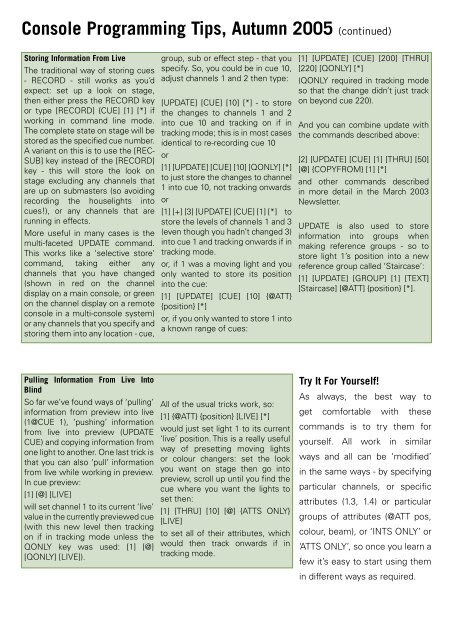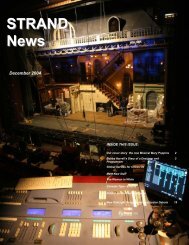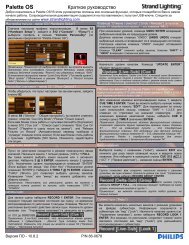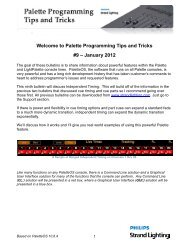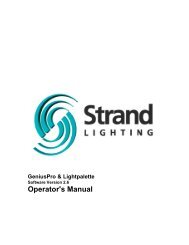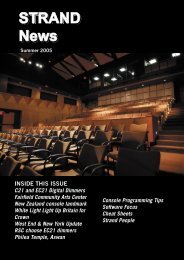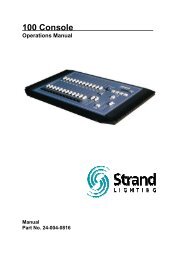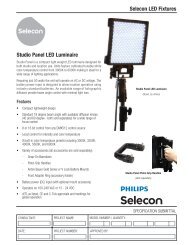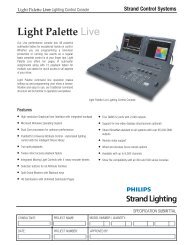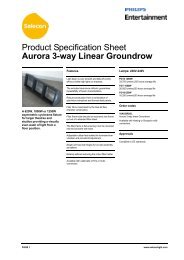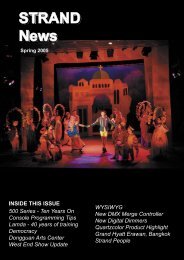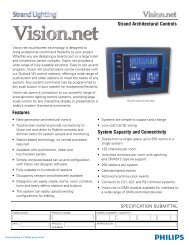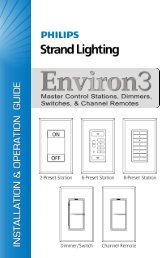STRAND News - Strand Lighting
STRAND News - Strand Lighting
STRAND News - Strand Lighting
Create successful ePaper yourself
Turn your PDF publications into a flip-book with our unique Google optimized e-Paper software.
Console Programming Tips, Autumn 2005 (continued)<br />
Storing Information From Live<br />
The traditional way of storing cues<br />
- RECORD - still works as you’d<br />
expect: set up a look on stage,<br />
then either press the RECORD key<br />
or type [RECORD] {CUE] [1] [*] if<br />
working in command line mode.<br />
The complete state on stage will be<br />
stored as the specified cue number.<br />
A variant on this is to use the [REC-<br />
SUB] key instead of the [RECORD]<br />
key - this will store the look on<br />
stage excluding any channels that<br />
are up on submasters (so avoiding<br />
recording the houselights into<br />
cues!), or any channels that are<br />
running in effects.<br />
More useful in many cases is the<br />
multi-faceted UPDATE command.<br />
This works like a ‘selective store’<br />
command, taking either any<br />
channels that you have changed<br />
(shown in red on the channel<br />
display on a main console, or green<br />
on the channel display on a remote<br />
console in a multi-console system)<br />
or any channels that you specify and<br />
storing them into any location - cue,<br />
group, sub or effect step - that you<br />
specify. So, you could be in cue 10,<br />
adjust channels 1 and 2 then type:<br />
[UPDATE] [CUE] [10] [*] - to store<br />
the changes to channels 1 and 2<br />
into cue 10 and tracking on if in<br />
tracking mode; this is in most cases<br />
identical to re-recording cue 10<br />
or<br />
[1] [UPDATE] [CUE] [10] [QONLY] [*]<br />
to just store the changes to channel<br />
1 into cue 10, not tracking onwards<br />
or<br />
[1] [+] [3] [UPDATE] [CUE] [1] [*] to<br />
store the levels of channels 1 and 3<br />
(even though you hadn’t changed 3)<br />
into cue 1 and tracking onwards if in<br />
tracking mode.<br />
or, if 1 was a moving light and you<br />
only wanted to store its position<br />
into the cue:<br />
[1] [UPDATE] [CUE] [10] {@ATT}<br />
{position} [*]<br />
or, if you only wanted to store 1 into<br />
a known range of cues:<br />
[1] [UPDATE] [CUE] [200] [THRU]<br />
[220] [QONLY] [*]<br />
(QONLY required in tracking mode<br />
so that the change didn’t just track<br />
on beyond cue 220).<br />
And you can combine update with<br />
the commands described above:<br />
[2] [UPDATE] [CUE] [1] [THRU] [50]<br />
[@] {COPYFROM} [1] [*]<br />
and other commands described<br />
in more detail in the March 2003<br />
<strong>News</strong>letter.<br />
UPDATE is also used to store<br />
information into groups when<br />
making reference groups - so to<br />
store light 1’s position into a new<br />
reference group called ‘Staircase’:<br />
[1] [UPDATE] [GROUP] [1] [TEXT]<br />
[Staircase] [@ATT] {position} [*].<br />
Pulling Information From Live Into<br />
Blind<br />
So far we’ve found ways of ‘pulling’<br />
information from preview into live<br />
(1@CUE 1), ‘pushing’ information<br />
from live into preview (UPDATE<br />
CUE) and copying information from<br />
one light to another. One last trick is<br />
that you can also ‘pull’ information<br />
from live while working in preview.<br />
In cue preview:<br />
[1] [@] [LIVE]<br />
will set channel 1 to its current ‘live’<br />
value in the currently previewed cue<br />
(with this new level then tracking<br />
on if in tracking mode unless the<br />
QONLY key was used: [1] [@]<br />
[QONLY] [LIVE]).<br />
All of the usual tricks work, so:<br />
[1] {@ATT} {position} [LIVE] [*]<br />
would just set light 1 to its current<br />
‘live’ position. This is a really useful<br />
way of presetting moving lights<br />
or colour changers: set the look<br />
you want on stage then go into<br />
preview, scroll up until you find the<br />
cue where you want the lights to<br />
set then:<br />
[1] [THRU] [10] [@] {ATTS ONLY}<br />
[LIVE]<br />
to set all of their attributes, which<br />
would then track onwards if in<br />
tracking mode.<br />
Try It For Yourself!<br />
As always, the best way to<br />
get comfortable with these<br />
commands is to try them for<br />
yourself. All work in similar<br />
ways and all can be ‘modified’<br />
in the same ways - by specifying<br />
particular channels, or specific<br />
attributes (1.3, 1.4) or particular<br />
groups of attributes (@ATT pos,<br />
colour, beam), or ‘INTS ONLY’ or<br />
‘ATTS ONLY’, so once you learn a<br />
few it’s easy to start using them<br />
in different ways as required.


